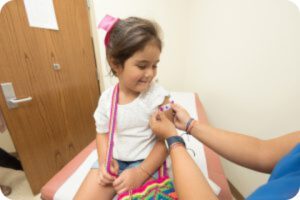Remember when COVID-19 forced schools to shut down, triggered shortages of food, hand sanitizer and toilet paper, and canceled our holiday gatherings? These hardships won’t soon be forgotten. Many families even chose to delay routine check-ups and well-child visits due to rising infection rates across Minnesota. Now providers across the state are sending a reminder to families with infants, small children and kids of all ages: It’s time to come back and see us for your routine check-ups and immunizations.
It’s important to check with your child’s provider to find out which immunizations are past due. Vaccines protect babies and kids from serious preventable diseases. Minnesota health officials say vaccination rates for two-year-old children decreased in 2021 compared to 2019. They say it’s important to get caught up with immunizations to keep your kids healthy. Knowing which vaccines are recommended can be confusing. The Centers for Disease Control and Prevention (CDC) provides parent-friendly immunization schedules as a handy reference. Wondering which immunizations your child has already received? Call your child’s clinic or contact the Minnesota Department of Health. You’ll get an up-to-date record, even if your child received immunizations from different providers.
Safety
Talk to your child’s healthcare provider about which immunizations are needed to catch up. Face-to-face conversations are an effective way to learn why certain vaccines might be due, what diseases they prevent and any possible side effects. Some parents have questions about why vaccines are necessary and if they are safe for their child. Vaccines prevent diseases like polio, hepatitis A, whooping cough and measles. Before they are approved, vaccines undergo extensive testing to ensure they are safe for your child at each stage of growth. According to the CDC, the current supply of vaccines is the safest in U.S. history.
The big 10
Below is a quick overview of vaccines given to most babies, from birth up to 23 months. Most newborns get their first shot, the hepatitis B vaccine or HepB, within their first 24 hours of birth. This vaccine protects them against hepatitis B, a contagious liver disease that can be serious. Typically, a second dose is given at 1-2 months and a third dose at six to 18 months.

One to Two Months The DTaP vaccine is given in five doses, and protects against diphtheria, tetanus and whooping cough. All three of these diseases can be serious. Diphtheria starts with a sore throat, fever and chills and then causes a thick coating in the back of the nose or throat. Tetanus is caused by bacteria that produces a toxin found in soil, dust and manure. The toxin can enter the body through breaks in the skin. Symptoms include muscle stiffness, jaw cramping and difficulty swallowing. Whooping cough is a respiratory illness that can cause coughing fits that can include gasping for air, making a “whooping” sound. At two months babies also receive their first dose of the Hib vaccine, which protects against Haemophilus influenzae type b (Hib). Hib can cause a variety of diseases, including meningitis and pneumonia. Other immunizations that start at 1-2 months include vaccines for Polio (IPV), Pneumococcal disease (PCV) and Rotavirus (RV). Polio is a serious, disabling and even life-threatening disease caused by the polio virus. It can affect the spinal cord, causing paralysis or muscle weakness. Pneumococcal disease is an illness caused by bacteria. It can cause infections of the lungs, ears, blood and the lining of the brain and spinal cord. Rotavirus can be serious, causing diarrhea and vomiting and fever in young children. A second dose of HepB is also given.
Four months At this age, most babies receive second doses of the vaccines given to them at 1-2 months. They include: DTaP, Hib, IPV, PCV, and RV.
Six months This is the age when most babies can receive a new vaccine: the flu shot. Experts recommend an annual flu shot because the flu virus changes each year and because protection gradually wears off. Babies and children receiving the vaccine for the first time get two doses at least four weeks apart. The flu (influenza) is contagious and primarily affects the nose, throat, upper airways and the lungs. Babies also receive third doses of DTaP, Hib, IPV, PCV and RV. A third dose of HepB is given between 6-18 months.
12-23 months
The MMR vaccine (MMR) is a combination vaccine providing protection against measles, mumps and rubella. Some people question the safety of this vaccine because of false rumors and misinformation. MMR is safe. Contrary to some claims, MMR does NOT cause autism. This vaccine has been studied carefully by scientists in the U.S. and other parts of the world. Measles, however, is a potentially serious and highly contagious respiratory disease that causes a rash and other symptoms. Rare cases lead to pneumonia, brain damage, deafness and even death. Mumps can also be dangerous. It causes puffy cheeks and swollen glands, along with fever, headaches and tiredness. In rare cases it can cause meningitis (swelling of the tissue surrounding the brain and spinal cord), encephalitis (swelling of the brain) and deafness. A first dose of the Hepatitis A vaccine (HepA) is given at this age to protect babies against the virus that causes hepatitis A, which is a serious liver disease. The third new immunization is the chicken pox vaccine (varicella). Chicken pox is a highly contagious disease that causes an itchy rash of blisters and a fever. Rare cases can lead to skin infections, dehydration, pneumonia, encephalitis and even death. Babies also receive their third dose of DTaP, IPV, PCV and RV, and a fourth dose of Hib.
This article is presented by a collaboration of Minnesota health plans working to promote a healthy start for Minnesota children. Thank you to Blue Plus, HealthPartners, Hennepin Health, Medica, South Country Health Alliance and UCare, for their commitment to this issue.

